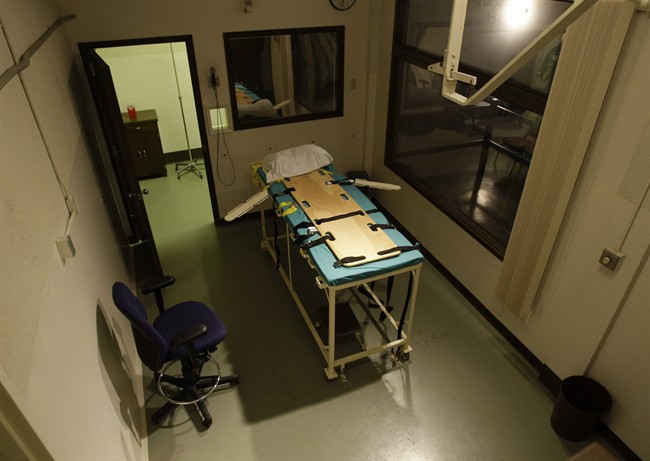TORONTO – A series of botched lethal injections and a pending Supreme Court review are prompting American lawmakers to consider returning to forms of execution once thought long gone.

Several death-penalty states have voted in favour of a return to firing squads, gas chambers and even the electric chair as alternative forms of execution for prisoners on death row.
READ MORE: Masking death penalty’s violence increases suffering, Arizona execution shows
In Wyoming, a bill passed the state’s House of Representatives Thursday to make death by firing squad an alternative method of execution, provided inmates are rendered unconscious through sedation before being shot.
WATCH: Wyoming considers firing squads as alternative to lethal injection
Republican representative Nathan Winters told told NBC affiliate KCWY he believes lethal injection is still a better form of execution but a second option is needed.
“…If they are going to have an execution they have the responsibility to make sure they have the most humane method possible,” Winters said. “When someone commits a heinous act we don’t have to respond in the same kind of cruelty that they perpetuated on a victim.”
Some have questioned the need for new legislation: Wyoming’s death row has been empty since a federal judge overturned an inmate’s death sentence in the fall of 2014.
Oklahoma lawmakers are considering two separate bills that would allow the department of corrections to bring back the gas chamber. The procedure would kill inmates through nitrogen hypoxia, which depletes the supply of oxygen in the blood.
“The people who have experienced it up to the point of unconsciousness said it was a euphoric feeling,” Rep. Mike Christian told the Associated Press.
“If they’re saying it’s euphoric, I’d say it’s more humane.”
READ MORE: Oklahoma to resume executions after 9-month delay
But the Oklahoma chapter of the American Civil Liberties Union, which has campaigned against capital punishment, takes issue with that reasoning.
“It’s absurd to try to chase down a more humane way to intentionally take the life of another human being against their will,” said Ryan Kiesel, director of Oklahoma’s ACLU, told AP.
Tennessee currently allows the use of the electric chair if officials can’t access the drugs for lethal injection. Missouri and Utah are attempting to reinstate firing squads as backup methods to injections.
Canada began to stop using the death penalty in 1963 and formally abolished it in 1976. Critics in the U.S. say older forms of execution often resulted in “painful, grisly spectacles.”
- Toronto’s construction season traffic is ‘unacceptable.’ Is there a better way?
- More foreign interference action coming after inquiry report, India arrests: LeBlanc
- Why MP questions put the Bank of Canada governor in a political minefield
- Amid bird flu spread, Canada boosts surveillance and testing at border
“The person being executed could experience extreme pain and foreboding. Executions by the older methods of execution often were painful, grisly spectacles.” Richard Dieter, executive director of the Death Penalty Information Center, told Global News in an email. “If that occurs, those methods could be struck down, leaving the state in a difficult position, because presumably they used an older method because they determined lethal injection was impossible.”
Dieter adds that in conservative states like Wyoming the death penalty is largely symbolic.
Lethal injections have come under fire after injections failed to kill inmates, but caused them what their lawyers allege was extreme suffering, often keeping them alive for many minutes or hours after the drug was administered.
In April 2014, the execution of Clayton Lockett took 43 minutes; according to witnesses he “writhed and groaned” in pain during the lengthy ordeal. Then in July, the State of Arizona took nearly two hours to execute inmate Joseph Wood, although authorities argued he was not in pain for the majority of the time.
The U.S. corrections department has cited decreasing availability of the drug pentobarbital as being problematic for the future use of lethal injection, following an EU decision to stop selling the drug.
*With files from the Associated Press




Comments